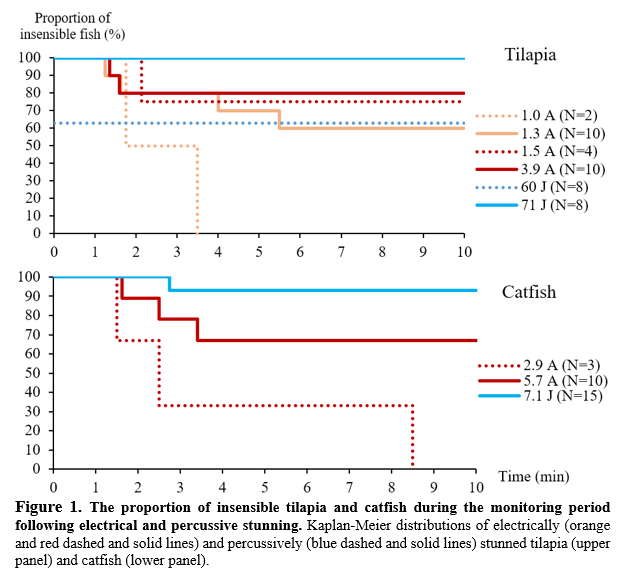BETTER STUNNING, BETTER QUALITY: IMPACTS OF STUNNING METHOD ON BRAIN FUNCTION AND PRODUCT QUALITY IN TILAPIA Oreochromis niloticus AND CATFISH Clarias gariepinus
Background
With increasing societal and regulatory focus on ethical practices in aquaculture, the identification of humane stunning and killing methods has become imperative. Electrical and percussive stunning techniques have been proposed as viable means to minimize suffering by ensuring rapid and sustained loss of sensibility. However, for species extensively farmed for human consumption, such as Nile tilapia (Oreochromis niloticus) and African sharptooth catfish (Clarias gariepinus), it is critical to evaluate stunning methods not only in terms of welfare but also regarding their effects on product quality. A multidisciplinary approach, combining assessments of brain function with product quality, provides critical insights into the broader implications of stunning practices.
Material and methods
Electrical s tunning was performed using an in-air electrical stunner prototype (Optimar AS, Norway) delivering a 20 s stun at maximum current of ~3.9 A for tilapia and ~5.7 A for catfish . Percussive stunning was carried out with an automated percussive stunner (Baader, Germany), s et to deliver ~60 J (velocity of ~ 28 ms⁻¹ ) and ~71 J (velocity of ~ 31 ms⁻¹ ), for tilapia, while catfish were expose d only to the higher settings.
Immediately post- stunning, electroencephalogram (EEG) electrodes were attached to record brain function continuously for 10 min . Stunning effectiveness was determined by the presence or absence of visually evoked responses (VERs) in the EEG recordings. All groups assessed for VERs are presented in Figure 1. P roduct quality assessments were conducted only on g roups subjected to maximum stunning intensities , evaluating water holding capacity and rigor mortis progression . The water-holding capacity of flesh was measured as drip loss (%) which was determined as percentage weight loss relative to initial fillet weight at 4, 24, 48, 72, and 96 hours post-stunning (n = 8 per group). Rigor mortis was monitored hourly over 7 h post-stunning , quantified via a rigor index (% ) based on vertical displacement of the caudal fin ( n = 6 per group ).
Results
At the lower electrical stunning intensities , 25-100 % of tilapia and 100% of catfish recovered during monitoring, whereas at maximum intensity, recovery decreased to 20% in tilapia and 67% in catfish (Fig. 1). For tilapia, percussive st unning at ~60 J was insufficient to ensure insensibility in all individuals; however, ~71 J achieved a 100% success rate. In catfish, one recovery occurred after percussive stunning (~71 J), attributed to a misaligned strike targeting the nose rather than the brain. Preliminary analyses indicated that d rip loss increased more rapidly over time in electrically stunned tilapia compared to percussively stunned individuals (Time x Treatment: F2.0,28.5 = 13.7 , p < 0.001). Also i n catfish, drip loss was significantly higher in electrically stunned individuals compared to those stunned percussively (Treatment: F1.0,14.0 = 5.1, p = 0.04). However, the difference in drip loss between groups remained consistent over time (Time x Treatment: F1.1,15.6 = 2.6, p = 0.124). The onset of rigor mortis typically occurred between 1 and 4 h post-stunning across methods. However, after 7 h, electrically stunned tilapia showed a significantly higher rigor index (87.0 ± 8.3%) than pe rcussively stunned fish (22.4 ± 5.8%, t9 = -6.7 , p < 0.001), while no differences were observed in catfish (7.9 ± 4.2% vs. 12.1 ± 2.5%, t10.0 = 0.9 , p = 0.205).
Conclusions
In both tilapia and catfish, a proportion of individuals regained brain function following electrical stunning . Although increasing stun intensity improved stunning efficacy , this was associated with compromised product quali ty, increasing drip loss and accelerating the development of rigor mortis, thus having a negative impact on water holding capacity, processing, and texture of the flesh. Automatic percussive stunning achieved higher welfare outcomes when appropriate force and accuracy were applied and better preserved product quality. Our findings demonstrate that percussive stunning may be a commercially viable solution for tilapia and catfish, aligning both we lfare and quality objectives . Further research should explore the consistency of force and accuracy under large-scale commercial production conditions.
